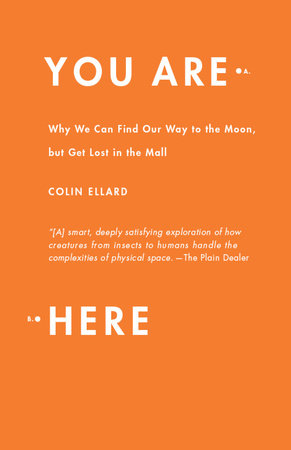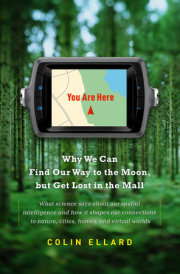Chapter 1Looking For TargetsSimple Tactics for Finding Our Way
That We Share With All Other Animals
Following the light of the sun, we left the Old World
We’ve all done it. At a meeting, a conference, a wedding, or a simple potluck gathering with friends, the food appears. Though manners may prompt us to restrain ourselves for a few minutes, our antennae wave, our restless feet shuffle, and we make a beeline for the tables. If a scientist were to hover above us and measure our movements, it would be easy to show the average guest-to-plate distance as a steadily decreasing mathematical function. This class of behavior, called taxis, is the simplest kind of spatial behavior that can be imagined. All that is required is a target (that magnificent roast of beef), a sensor or two (our well-tuned nostrils and eyes), and some kind of motive force (sore feet squeezed into formal shoes will do nicely).
Life does not always treat us so kindly, though. On our way to the table, Longtalker Larry makes a perfect intercept course. How to rearrange the missile trajectory so as to home in on the canapés while avoiding verbal entanglement with Larry? The buffet table has two rows of food. On the closest side is Aunt Betty’s famous potato salad, but it looks a little bland. The better bet is Sarah’s Spicy Potatoes, but they’re just out of reach. We’ll need to thread our way through a crowd, momentarily losing sight of the target completely, in order to plan the return foray to starch Valhalla on the distal side of the room. What’s the quickest way? Perhaps the party is in a building we’ve never seen before. The sweet aromas are everywhere, but compared to what vision gives us, they don’t make much of a spatial cue. Which way do we go first? How do we conduct an efficient search?
Compared with many of the stories of feats of navigation that I will relate to you, finding your way to and then around a table full of food is small potatoes (Sarah’s if you’re lucky). Nevertheless, all such behaviors, ranging from the trivially simple taxis to the complex wayfinding task, point to one basic truth of biology. Unlike the potted geranium sitting in my window, you and I, like all other animate beings, need to be able to move from one place to another to survive. In order to remain nourished, I must get up from my chair and go to the fridge to find food. In order to avoid a premature demise, I need to leap out of the way of the bus that hurtles down the road toward me. The whole raw biological point of my individual survival is to reproduce. But this, too, requires movement. In order to pass my genes on, I need to be able to get up and walk around until I find a mate. (This, you may argue, is something of an oversimplification.) To survive, we must come to terms with space and time. Whatever the physicists and philosophers might say about these things, movement is defined as a change in place over some duration of time. Given this, it is not at all surprising that nature has produced a wide array of mechanical devices that produce movement (legs, wings, fins, and so on). In addition, we have evolved an even more impressive arsenal of tools that allow us to know where to move—that is, to find our way through space to important goals such as sustenance, warmth, safety, and sex.
The simplest tricks of navigation are perhaps so obvious that we don’t even think of them as being tricks. You are walking down the aisle in a grocery store when, just ahead of you, you see the box of spaghetti you’ve been seeking. With little or no conscious effort, the box is soon in your hand and then in your shopping cart. What’s to explain? This seemingly trivial piece of behavior—moving to a clearly visible target—is something that we do hundreds of times a day. Such behaviors are required of all animals that move, yet they are accomplished in a wide variety of ways.
The most primitive kinds of animals, one-celled creatures such as bacteria, though their needs may be simple, must still possess a basic toolkit that allows them to find their way to conditions that sustain life: light, heat, and sustenance. Sometimes these unicellular denizens of our soil, water, and even our own bodies can employ a search strategy much like a child playing a game of blind man’s bluff. Their rates of movement rise and fall with the activity of sensors tuned to the concentrations of heat, light, or chemicals that surround them, and these changes in movement bring them inexorably into contact with their goal. Other than the movement of a plant bending toward the light, it is difficult to imagine a simpler mechanism by which a living thing can deal with the problems of space.
In other cases, such tiny creatures as these may possess specialized equipment to help them guide their movements. In 1996, a group of scientists, headed by Dr. David McKay of NASA’s Johnson Space Center, claimed they had discovered fossil evidence for the existence of life on Mars in a lump of meteoric rock that had been collected from the Antarctic. Analysis of the chemical composition of the rock left little doubt that it was of Martian origin, and the peculiar formations inside the rock looked suspiciously biological. Researchers thought they could see tiny cell bodies, reminiscent of our own earthly bacteria.
As some of McKay’s early evidence has been disputed by others, the initial excitement has died down, but he remains convinced that the particles of magnetite that were found in the sample once constituted a part of a Martian life form. Magnetite is found in various places on our planet, but one of the most interesting homes for this magnetic mineral is inside single-celled organisms that employ a unique style of navigation. So-called magnetotaxic animals use particles of magnetite as tiny compasses that orient their bodies with planetary geography. Though these magnetite bodies take advantage of the earth’s magnetic field in exactly the same way that makes the Boy Scout compass face north, in this case it is not to help them to read maps correctly but to do something much simpler: the magnetite pulls these tiny aquatic animals downward into the lakebeds lining their watery homes, where they find food, safety, and comfortable temperatures. The origin of the magnetite found in McKay’s samples is a matter that still swirls in controversy, but if he is correct, not only will his discovery constitute the first evidence of extraterrestrial life but his claim will be based on an elementary form of navigation.
Copyright © 2010 by Colin Ellard. All rights reserved. No part of this excerpt may be reproduced or reprinted without permission in writing from the publisher.








